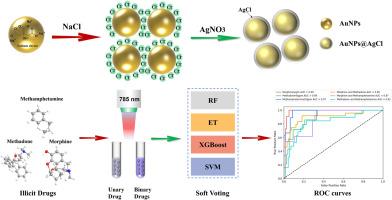Molecular enrichment integrated with soft voting for efficient SERS detection of multiple drugs
IF 6
2区 化学
Q1 CHEMISTRY, ANALYTICAL
引用次数: 0
Abstract
Background
Surface-enhanced Raman spectroscopy (SERS) is regarded as a powerful tool for rapid drug identification in the liquid phase. However, the implementation of SERS for drug detection in the liquid phase remains constrained by two critical limitations: inadequate molecular enrichment efficiency at hotspots and spectral interpretation difficulties arising from complex multi-analyte interactions. Besides, manual scrutiny of large-scale SERS datasets is painstakingly slow and overwhelmingly labor-intensive. Currently, it is clear that an effective molecular enrichment strategy combined with machine learning models with high accuracy are research hotspots. (85)Results
We designed a novel AuNPs@AgCl (Au nanoparticles (AuNPs) modified with activated sealing layer of AgCl) substrate through the reaction of Cl- ions and Ag+ ions to address these issues. This substrate achieved ultralow detection limits for diverse substances: 4 × 10−11 M for crystal violet, 0.2 ppm for morphine, 12.5 ppm for methamphetamine, and 10 ppm for methadone. Meanwhile, the results showed that the AuNPs@AgCl substrate was able to quantify methadone spiked in lake water, artificial saliva and artificial blood with a lower limit of detection of 50 ppb, 0.8 ppm, and 0.6 ppm, respectively. Furthermore, we developed a soft voting classifier which incorporates random forest (RF), extra-trees (ET), XGBoost and support vector machine (SVM) models. This architecture delivers 90.7% average accuracy in classifying 6 drugs combinations (unary/binary mixtures), outperforming single-algorithm approaches by 21.4-26.7%. (134)Significance
This rationally designed substrate effectively improved the probability of analytes falling into hotspots and enhanced SERS stability. Besides, the soft voting classifiers have demonstrated their great potential to improve the classification accuracy for both unary and binary drugs in a balanced manner. This synergistic combination of molecular enrichment and soft voting classifier holds great potential for drug detection applications. (59)

分子富集与软投票相结合,用于多种药物的高效SERS检测
背景表面增强拉曼光谱(SERS)被认为是快速液相药物鉴定的有力工具。然而,在液相中使用SERS进行药物检测仍然受到两个关键限制的制约:热点处分子富集效率不足以及多分析物复杂相互作用带来的光谱解释困难。此外,大规模SERS数据集的人工检查非常缓慢,而且非常耗费人力。目前,有效的分子富集策略与高精度的机器学习模型相结合显然是研究热点。(85)结果通过Cl-离子和Ag+离子的反应,设计了一种新型的AuNPs@AgCl (Au)纳米颗粒(AuNPs),该纳米颗粒被活化的AgCl密封层修饰)底物。该底物对多种物质具有超低检测限:结晶紫为4 × 10−11 M,吗啡为0.2 ppm,甲基苯丙胺为12.5 ppm,美沙酮为10 ppm。同时,AuNPs@AgCl底物能够定量检测湖水、人工唾液和人工血液中的美沙酮,检测下限分别为50 ppb、0.8 ppm和0.6 ppm。此外,我们开发了一个软投票分类器,它结合了随机森林(RF)、额外树(ET)、XGBoost和支持向量机(SVM)模型。该架构对6种药物组合(一元/二元混合物)进行分类的平均准确率为90.7%,比单一算法方法高出21.4-26.7%。(134)意义合理设计底物有效提高了分析物落入热点的概率,增强了SERS稳定性。此外,软投票分类器在平衡地提高一元和二元药物的分类精度方面显示出了巨大的潜力。这种分子富集和软投票分类器的协同组合在药物检测应用中具有很大的潜力。(59)
本文章由计算机程序翻译,如有差异,请以英文原文为准。
求助全文
约1分钟内获得全文
求助全文
来源期刊

Analytica Chimica Acta
化学-分析化学
CiteScore
10.40
自引率
6.50%
发文量
1081
审稿时长
38 days
期刊介绍:
Analytica Chimica Acta has an open access mirror journal Analytica Chimica Acta: X, sharing the same aims and scope, editorial team, submission system and rigorous peer review.
Analytica Chimica Acta provides a forum for the rapid publication of original research, and critical, comprehensive reviews dealing with all aspects of fundamental and applied modern analytical chemistry. The journal welcomes the submission of research papers which report studies concerning the development of new and significant analytical methodologies. In determining the suitability of submitted articles for publication, particular scrutiny will be placed on the degree of novelty and impact of the research and the extent to which it adds to the existing body of knowledge in analytical chemistry.
 求助内容:
求助内容: 应助结果提醒方式:
应助结果提醒方式:


